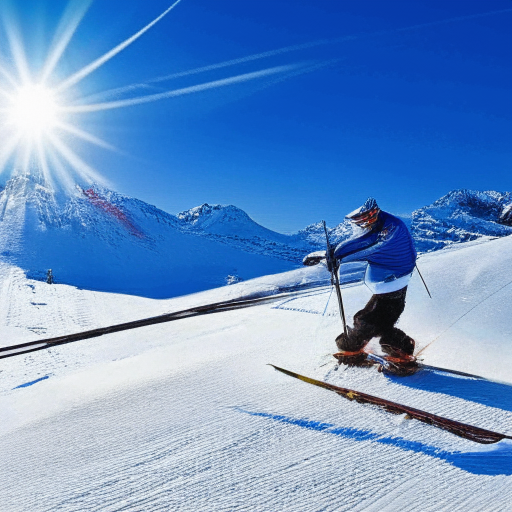Protect Your Vision: A Comprehensive Guide to Understanding and Preventing Snow Blindness
As the magical winter season envelops the landscape in a beautiful layer of snow, it's vital to be aware of the potential hazards that come with outdoor adventures in such environments. One of the most critical dangers is snow blindness, which is a temporary yet intensely painful condition caused by excessive exposure to ultraviolet (UV) rays that are reflected off snow. This detailed blog post explores the intricate science behind snow blindness, analyzes the effects of sunlight reflecting off snow, and offers practical tips for effective prevention, accurate diagnosis, and appropriate treatment. By gaining insight into the underlying causes of this condition and implementing protective measures, we can fully appreciate the beauty of winter while also safeguarding our eye health.

Understanding Snow Blindness: Medical Definitions and Underlying Causes
The medical term for snow blindness is photokeratitis, indicating a temporary injury to the cornea, the eye's protective outer layer. This painful condition primarily results from prolonged exposure to elevated levels of ultraviolet (UV) radiation, especially from sunlight reflecting off snow-covered surfaces. The intense sunlight, particularly at higher altitudes where the atmosphere is thinner, can lead to significant discomfort and may even result in long-term vision issues in certain cases. Although snow blindness typically resolves on its own within a short timeframe, understanding its triggers is essential for implementing effective prevention and management strategies that contribute to lasting eye health.
The Effects of Sunlight Reflection on Snow and Eye Health
To fully understand the intricacies of snow blindness, one must examine how sunlight interacts with the surface of snow. Sunlight travels through the atmosphere in various wavelengths, including harmful ultraviolet radiation. When these rays strike a snow-covered terrain, snow's unique reflective properties can bounce back as much as 80% of these UV rays, dramatically increasing exposure levels. This reflection is particularly pronounced in elevated regions where the atmosphere's capacity to filter UV radiation is significantly diminished. As a result, the eyes can quickly become overwhelmed by excessive UV exposure, leading to potential damage to critical eye components such as the cornea and conjunctiva.
Identifying the Symptoms of Snow Blindness for Quick Response
The symptoms of snow blindness usually become noticeable several hours following exposure to intense UV light. While the severity of symptoms can differ among individuals, common indicators include:
Eye discomfort and pain: Many individuals experience a gritty sensation or the feeling of foreign objects in their eyes.
Redness and swelling: The eyes may appear bloodshot, with eyelids swelling and showing signs of inflammation.
Watery eyes: The body produces tears as a natural defense mechanism to flush out irritants and alleviate discomfort.
Blurry vision: Tasks requiring clear sight, such as reading or driving, may become challenging due to visual distortions.
Sensitivity to light: Increased sensitivity to light, known as photophobia, often accompanies headaches.
Sensation of halos: Some individuals may notice bright rings or halos around light sources, contributing to visual confusion.
Proactive Measures to Shield Your Eyes from Snow Blindness
When it comes to protecting your eyes from the harmful effects of UV exposure, taking proactive steps is far more effective than seeking solutions after symptoms arise. Here are several useful tips to help you minimize the risk of snow blindness:
Select appropriate eyewear: Always choose goggles or sunglasses that block 100% of UV rays when venturing into snowy environments. Look for eyewear labeled with UV400 or 100% UV protection for optimal safety.
Opt for wraparound designs: Choose sunglasses or goggles that wrap around the sides of your face to provide comprehensive protection against both direct sunlight and side UV exposure.
Wear wide-brimmed hats: Hats with wide brims or neck flaps can offer additional shade, significantly lowering UV exposure to your eyes.
Check the UV Index: Prior to engaging in outdoor activities, consult the local UV Index, which indicates daily UV exposure levels. Be cautious about limiting sun exposure during peak hours, typically between 10 AM and 4 PM.
Apply sunscreen strategically: Although it may seem unrelated, applying sunscreen around your face and eyes can significantly reduce UV exposure, enhancing your overall eye protection.
Take regular breaks indoors: If you plan to spend extended periods in snowy areas, make it a habit to take breaks indoors, allowing your eyes to rest and recover from intense light exposure.
Effective Relief and Recovery Strategies for Snow Blindness Symptoms
If you find yourself experiencing symptoms of snow blindness despite taking preventive measures, several strategies can help soothe discomfort and promote recovery:
Seek shade immediately: Move to a darkened area or indoors to shield your eyes from further UV exposure.
Remove contact lenses: If you wear contact lenses, take them out to avoid additional irritation and allow your eyes to recuperate properly.
Utilize cold compresses: Applying a cold, damp cloth over closed eyes can effectively soothe discomfort and reduce swelling.
Use artificial tears: Over-the-counter artificial tears can provide temporary relief, keeping your eyes lubricated and alleviating dryness associated with snow blindness.
Avoid bright lights: Minimize exposure to intense light sources, including screens and overhead lighting, to lessen the effects of photophobia during recovery.
Rest your eyes diligently: Engage in minimal visual strain activities, steering clear of reading or screen time, to give your eyes the essential time they need to heal.
When to Seek Medical Attention for Persistent Snow Blindness Symptoms
In most cases, the symptoms of snow blindness will begin to subside within 24 to 48 hours as the cornea heals. However, it is crucial to seek medical assistance if symptoms worsen or persist, as delays in treatment could result in complications or secondary infections.
Experiencing snow blindness can significantly diminish the enjoyment of winter activities, but with informed knowledge and precautionary measures, we can greatly mitigate the risks while fully immersing ourselves in the stunning beauty of snowy landscapes. Stay vigilant about UV radiation levels, take regular breaks in shaded areas, and always prioritize protective eyewear. If symptoms develop, seek relief promptly and consult a healthcare professional if necessary. By prioritizing eye safety, you can fully embrace the winter wonderland and create lasting memories without compromising your vision. Approach your winter adventures with care!
The post Snow Blindness: Understanding Its Causes and Effects appeared first on Survival Bite.
The Article Snow Blindness Causes and Effects Explained Was Found On https://limitsofstrategy.com
The Article Snow Blindness: Understanding Its Causes and Effects First Appeared ON
: https://ad4sc.com


This is such an important topic, especially for those of us who love winter sports! I remember the first time I went snowboarding and completely forgot to wear my goggles. The glare off the snow was brutal, and I had no idea how sensitive my eyes were until it was too late. It really puts things into perspective about how essential protective eyewear is—not just for snow blindness, but for overall eye health.
It’s great to hear your thoughts. Your experience really highlights how quickly we can underestimate the impact of conditions while enjoying winter sports. Snow can be incredibly reflective, amplifying the sun’s rays and making it crucial to protect our eyes. Many don’t realize that the effects can be immediate and lasting.
“Absolutely, it’s amazing how easily we can overlook the importance of eye protection on the slopes! If you’re looking for reliable eyewear options, check out this link for some top choices that combine safety and style.”
https://notpotatoes.com/webilaro
This is such an important topic, especially for those of us who enjoy winter sports or activities. I experienced mild snow blindness once during a day of skiing, and it was a painful reminder of how easily we can overlook eye protection in bright snowy conditions.
I can relate to your experience with snow blindness; it’s surprising how quickly such a beautiful day on the slopes can turn painful. I had a similar experience while snowboarding a few years back. I underestimated the sun’s glare off the snow, and it ended up being an uncomfortable ride back to the lodge. It’s a stark reminder of how crucial eye protection is in those bright, reflective conditions.
It’s interesting how a beautiful day can turn into a lesson, isn’t it? The sun’s glare can definitely catch you off guard, especially when you’re having fun on the slopes. When I had my bout with snow blindness, it really hit home for me how important it is to make eye protection a priority. It’s tempting to soak in all that bright winter sunshine without thinking about the consequences, but those reflective surfaces can be relentless.
This post really resonates with me, especially as I love spending time outdoors during winter. I’ve always been fascinated by how something as enjoyable as skiing or snowshoeing can come with hidden dangers like snow blindness. It’s interesting to think about how our beautiful winter landscapes can also pose risks to our health if we’re not careful.
I really appreciate your thoughts on this. Spending time outdoors in winter can be such a peaceful escape, but you’re right about the hidden dangers—snow blindness is often overlooked. I remember the first time I went skiing and didn’t have proper eye protection. The glare off the snow was intense, and I experienced some real discomfort afterward. It was a stark reminder of how even the most beautiful experiences can come with risks.
This is such an important and timely topic! Having recently enjoyed a snowy getaway, I experienced firsthand the discomfort of bright reflections off the snow, even for just a short period. It really made me reflect on how easily one can underestimate the intensity of UV rays in winter. Your detailed breakdown of snow blindness and its underlying causes is not only informative but also a great reminder of how essential it is to take proper precautions.